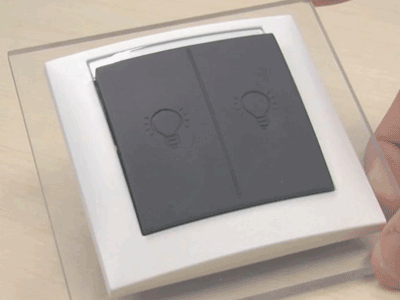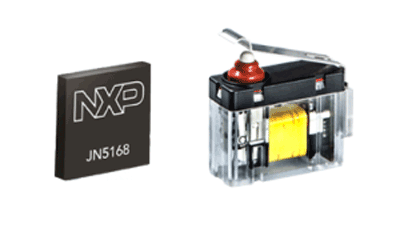How NXP and Cherry’s battery-less, wireless switch works
Product demonstrated at CES 2013 creates ton of buzz
At CES 2013, I was fortunate enough to get a working demonstration of Cherry’s new energy-harvesting wireless switch in the NXP tent. In case you haven’t heard of this product before, it was announced last year and does exactly as the name describes; that is, it provides houses and buildings with the ability to switch on and off lamps without any batteries or wires required.

The battery-less, wireless switch from Cherry and NXP.
The way in which the device works can be broken down to two main components: Cherry’s energy-harvesting switch and a radio. Data from the switch — turn on, turn off, fade up, fade down, etc. — is transmitted wirelessly via RF technology to NXP’s low-power JN5168 microcontroller, located inside the base of an LED bulb (generally speaking, it’s an E27 base). For those curious as to where the switch gets the power to transmit said data, the RF energy necessary for it to work is drawn from the mechanical actuation of the device by way of magnetic induction.

NXP’s JN5168 microcontroller and a Cherry switch.
It’s a pretty basic breakdown, but to the layman, a product like this means something even simpler: no more complex, expensive connection systems. To those more technically inclined, the way in which this system is set up means the switch won’t work with an LED bulb that does not have the NXP receiver somehow connected to it.
Now, this could be a headache, but it’s actually not that much of a problem because NXP’s JN5168 microcontroller can be purchased separately and is one of the most advanced receivers on the market today. It’s designed to also support JenNet-IP, ZigBee, and RF4CE networking stacks, the former of which is already being used in the popular GreenWave Reality Connected Lighting Solution product (which, by the way, just picked up a CES 2013 Best of Innovations award).
Being able to work with so many different networking stacks makes NXP’s microcontroller highly compatible, one that can be used for a host of other automation scenarios outside lighting. Such expansive compatibility allows the user to, in turn, use Cherry’s wireless switch to control applications like alarms, door locks, and windows.
The obvious question at this point: how much power does the NXP / Cherry switch actually use? Short answer: hardly any. Technical answer: 0.2 to 0.5 mW from the switch activation. The force required to push the switch: 8 newtons (just under two pounds of force).
Check out the video below in which Ian Morris, an application engineer at NXP, demonstrates this fascinating technology:
Learn more about the Cherry switch at: cherryswitches.com
Learn more about NXP’s JN5168 microcontroller at: nxp.com
■
Advertisement
Learn more about Electronic Products Magazine






